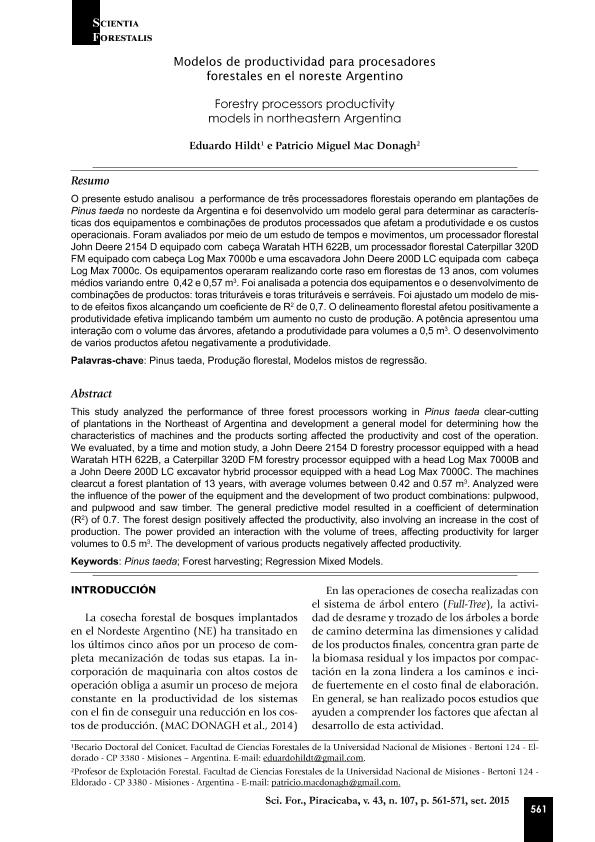Artículo
O presente estudo analisou a performance de três processadores florestais operando em plantações de Pinus taeda no nordeste da Argentina e foi desenvolvido um modelo geral para determinar as características dos equipamentos e combinações de produtos processados que afetam a produtividade e os custos operacionais. Foram avaliados por meio de um estudo de tempos e movimentos, um processador florestal John Deere 2154 D equipado com cabeça Waratah HTH 622B, um processador florestal Caterpillar 320D FM equipado com cabeça Log Max 7000b e uma escavadora John Deere 200D LC equipada com cabeça Log Max 7000c. Os equipamentos operaram realizando corte raso em florestas de 13 anos, com volumes médios variando entre 0,42 e 0,57 m3. Foi analisada a potencia dos equipamentos e o desenvolvimento de combinações de productos: toras trituráveis e toras trituráveis e serráveis. Foi ajustado um modelo de misto de efeitos fixos alcançando um coeficiente de R2 de 0,7. O delineamento florestal afetou positivamente a produtividade efetiva implicando também um aumento no custo de produção. A potência apresentou uma interação com o volume das árvores, afetando a produtividade para volumes a 0,5 m3. O desenvolvimento de varios productos afetou negativamente a produtividade. This study analyzed the performance of three forest processors working in Pinus taeda clear-cutting of plantations in the Northeast of Argentina and development a general model for determining how the characteristics of machines and the products sorting affected the productivity and cost of the operation. We evaluated, by a time and motion study, a John Deere 2154 D forestry processor equipped with a head Waratah HTH 622B, a Caterpillar 320D FM forestry processor equipped with a head Log Max 7000B and a John Deere 200D LC excavator hybrid processor equipped with a head Log Max 7000C. The machines clearcut a forest plantation of 13 years, with average volumes between 0.42 and 0.57 m3. Analyzed were the influence of the power of the equipment and the development of two product combinations: pulpwood, and pulpwood and saw timber. The general predictive model resulted in a coefficient of determination (R2) of 0.7. The forest design positively affected the productivity, also involving an increase in the cost of production. The power provided an interaction with the volume of trees, affecting productivity for larger volumes to 0.5 m3. The development of various products negatively affected productivity.
Modelos de productividad para procesadores forestales en el noreste argentino
Título:
Forestry processors productivity models in northeastern Argentina
Fecha de publicación:
09/2015
Editorial:
Ipef-inst Pesquisas Estudos Florestais
Revista:
Scientia Forestalis
ISSN:
1413-9324
e-ISSN:
1413-9324
Idioma:
Español
Tipo de recurso:
Artículo publicado
Clasificación temática:
Resumen
Archivos asociados
Licencia
Identificadores
Colecciones
Articulos(CCT - NORDESTE)
Articulos de CTRO.CIENTIFICO TECNOL.CONICET - NORDESTE
Articulos de CTRO.CIENTIFICO TECNOL.CONICET - NORDESTE
Citación
Hildt, Eduardo; Mac Donagh, Patricio Miguel; Modelos de productividad para procesadores forestales en el noreste argentino; Ipef-inst Pesquisas Estudos Florestais; Scientia Forestalis; 43; 107; 9-2015; 561-571
Compartir




